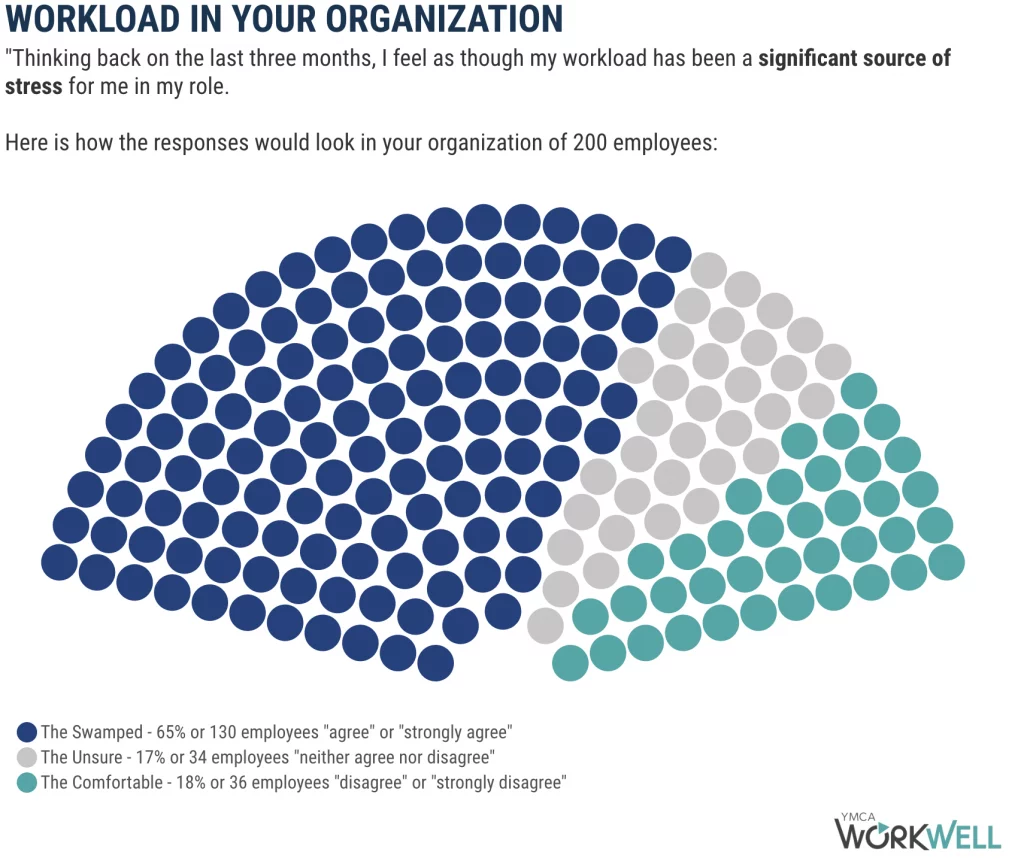This article was originally published by YMCA WorkWell and is reprinted with permission. Click here to view the original article.
At YMCA WorkWell, we’re on a mission to identify, research and take action on the top organizational challenges to employee well-being. Currently, our number one focus is burnout, and for good reason. Our 2021 Workplace Well-Being Report found that 73% of respondents reported feeling burnt out sometimes to very often, a statistic considerably higher than any we had seen before the pandemic. In our 2022 Special Interest Report this had risen slightly to 76%. In a recent blog, my colleague, Dr. Dave Whiteside, highlights why organizations should care so much about burnout. And if you’re an employee experiencing burnout yourself, please see my blog on strategies to help you. But in today’s blog we’re focusing in on the top cause of burnout: Workload.
Typically, when I mention workload in a professional development or consulting session, or a meeting with managers or senior leaders, I get a response something like this: “Yes, we know it’s a problem. We’re all drowning! But, there’s nothing we can actually do to change workload.” Perhaps this sounds familiar. And it begs the question: Are our heavy workloads inevitable? Are we truly powerless to address them in any meaningful way?
I’d like to challenge that while this may feel true, it isn’t. Instead, data shows us that we’re buying into this story. I don’t believe we need to stay on the hamster wheel of doing more with less. All it takes is the courage to stop the spin.
However, I also want to acknowledge that it isn’t easy. Full disclosure here: I started writing this blog on workload last year, got most of it done, and then my workload made it impossible for me to get to the last edits. What was meant to be a fall blog post is now a spring blog post. So, I get how hard this is, I really do. And it’s something that we are still working on at YMCA WorkWell, too.
Why is workload an issue?
Play along with me for a minute. Wherever you are right now – close your eyes (okay, finish reading the task first, and then close your eyes). Take five slow, deep breaths in and out through your nose. Then ask yourself, “How does my workload make me feel?” Pay attention to the thoughts and emotions that you are experiencing right now, as well as any tension or other physical experiences in your body. Now, take another minute or two to breathe and be mindful. Then open your eyes and come back to what I’ve got to share next.
Take an inventory of what you experienced – write it down or simply reflect. Is there a trend emerging? How does it feel to think about your workload?
If you’re feeling and experiencing workload like many of the clients I work with, I would bet there are a lot of negative emotions and indicators of stress that came up for you.
Why does this matter? Because that’s just one experience – yours. You need to magnify that by all the employees in your company, and then the scope of the problem that is workload becomes clear.
In our 2022 Special Interest Report, we looked more deeply at what was driving the Great Resignation. In figure 1 above, you can see that 2 out of 3 employees reported that their workload was a significant source of stress for them over the past three months. Anecdotally, we hear the same every time we are talking to leaders and their teams. Burnout can be defined as “a syndrome resulting from chronic workplace stress that has not been successfully managed.” If we agree that workload and burnout are correlated, and we accept this definition then we can see that there is a solution. We, as leaders and managers, just need to learn and then take intentional action to address the problem for our teams.
Working more does not equate to more or better work
For many, being busy – both professionally and personally – has become a badge of honour. There are a couple of interesting cultural norms to point out here: First, we often measure productivity by how many hours a person spends working or at work. Second, we tie motivation or care about career success to those hours worked. It goes something like this: “To be successful here, you need to be the first person in the office in the morning and the last to leave. That’s how you’ll get that senior management position”. This sentiment reared its head again in the discussion over return to workplace in 2021 and 2022, perhaps most famously when WeWork’s new CEO implied that engaged employees (the best, brightest and most motivated) want to return to an office while “those who are least engaged are very comfortable working from home.” And just like that attitude doesn’t represent the majority of workers (our own research and a variety of media articles support the call for increased work flexibility in terms of time and place), it is time to let go of the falsehood that more is always better, particularly for working hours and workload.
Our reverence for this culture of overwork may be killing us – yes metaphorically, though the increased stress is doing nothing for our overall physical health. The workplace and its psychosocial stressors are now the fifth leading cause of death in the US and the Japanese have a word for it: karoshi, translated as “death by overwork.” The Japanese Labour Ministry estimates that deaths from karoshi each year are roughly the same as those from traffic accidents. And, of course, this isn’t a phenomenon unique to Japan, as more and more people put in more and more hours at work each week. The thing is that research has found that productivity per hour declines sharply after 50 hours per week. And author Alex Pang advocates for “deliberate rest” as the “true key to productivity.”
So, if all those extra hours don’t actually lead to productivity, why does the myth persist? And why are we working all these hours? Beyond the motivation/productivity myths, I believe it’s trying to keep up with our workload in our “always on” culture – but at the expense of our well-being and happiness.
Start with mindset
In order to address workload and ensuing burnout, the first step is to tell it like it is. Workload is in our control. Overworking isn’t necessary or glamourous. Being perpetually busy is not a status symbol. As managers and leaders, there are concrete steps we can take, and it starts with modeling the way ourselves.
First: be a workload disrupter. That’s right, once you know that you have power over workload, wield it. And help your teams do the same. Start with getting real clear on priorities. What is most important for your team and each person on it? Get them involved in identifying priorities and barriers. Make sure that the best working time, when people are fresh and focused, is spent on those high-priority items. Remember: if we say everything is a priority, nothing is a priority. Next, foster open communication and normalize asking for help. Get off the hamster wheel – and take your teams with you.
Second: stand up to the excuses. Studies are clear here: working more hours and doing more doesn’t improve productivity. In fact, productivity wanes. Which means that high workloads are costing you money, not increasing your profits. If nothing else, think about the cost of absenteeism in your organization. Those overwhelming workloads are making people sick, and people who aren’t healthy aren’t performing at their best or able to give their all to the organization. Nor do they want to – just consider the rise of the term “quiet quitting” in the media this past fall.
Third: stand in your power. But, remember, with great power comes great responsibility. Take the time to measure the pulse of your team’s overall health and well-being (our Employee Insights Survey includes assessment of burnout and workload – and it’s a great tool, if we do say so ourselves). Celebrate where your team is excelling, support them where they need it.
Fourth: lead by example. Stick to your hours. Take your vacation. And encourage your teams to do the same. There’s never an ideal time – there will always be more work. Breaking the cycle is hard. Do it anyway.
If you know workload is a problem and fear burnout may have reared its ugly head on your teams, it’s not too late. In fact, there couldn’t be a better time to get started. You can manage workload – both for you and your team. And it’s worth the investment: less burnout, more engagement, more productivity. If you’re ready to get off the hamster wheel, we’re here to help.








